A Little Pepper With That?

As of 2004, 63 deaths involving pepper spray in police confrontations had occurred in the U.S. ― many more since, of course. Just do an online search for the words “pepper spray death police” and browse the horrific results. They’ve received prominent press coverage; you’d think that police departments everywhere would take those as cautionary tales, ensure thorough training in its use and the dangers thereof for all officers, and make it a weapon of close to last resort. After all, around 150 countries have banned the use of pepper spray in warfare, under Article I.5 of the Chemical Weapons Convention.
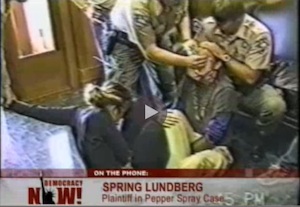
Humboldt County police officers apply cotton swab soaked in pepper spray to the eyelids of activist, fall 1997. Screeshot from police video.
Instead, a culture of reckless police use of pepper spray has taken hold. Nowhere has this proven more true than California, despite the widely publicized federal court ruling against the Humboldt County Sheriff’s Department in the 1997 Earth First! case. Indeed, California state law required the state to conduct and complete a health risk assessment before approving the use of pepper spray by police departments in 1992, but George Alexeeff, acting director of the California EPA’s Office of Health Hazard Assessment, has confessed that as of late 2011 “We never completed a risk assessment.” See Tom Hayden’s report in The Nation, November 23, 2011.
The Defense Technology Corporation, manufacturer of the MK-9 spray used on the UC Davis students, cautioned in an unpublished report back in the early ’90s that any use of OC (oleoresin capsicum) on a subject be limited to a single burst of not more than one second, adding that “… little or nothing is known about the health risk or toxicity of pepper spray, OC and other ingredients … Concerns on [sic] the safety and health risks associated with its use have arisen. OC sprays cause upper respiratory inflammation and may have detrimental effects on people with preexisting respiratory problems.”

In this report, Def-Tec goes into detail: “Furthermore, it is known that capsaicin directly affects nerves that transmit pain. Excessive stimulation to those neurons causes them to stop functioning properly. With continued stimulation, nerve death can result. Lastly, repeated administration of capsaicin [the active ingredient in oleoresin capsicum] has also resulted in liver necrosis …” (From the American Civil Liberties Union of Southern California’s June 1995 white paper, “Pepper Spray Update: More Fatalities, More Questions.” See also the 1995 report by Dr. C. Gregory Smith, “Health Hazards of Pepper Spray.”)
Whence That Whiz?
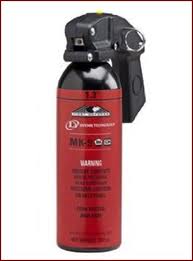
T Defense Technology 56895 MK-9 Stream, 1.3% Red Band/1.3% Blue Band Pepper Spray.
To wrap up this series of posts on the pepper-spray cop meme and the story in which it embeds itself, here’s a question apparently neither asked nor answered by any of the official investigating committees, nor by any journalist: How did these cops get their hands on military-grade pepper spray that they were not authorized to carry or trained to use, and that their department had no authority to purchase or supply to its officers?
The investigators make it clear in the Kroll/Reynoso Task Force report that they had to rely exclusively on documents provided to them by UC Davis, and were denied the opportunity to interview Lt. John Pike and Police Chief Annette Spicuzza. Still, we know that the police used MK-9 ― because the citizen-journalism stills and videos of the events of November 18, 2011 at UC Davis document it, and because it’s confirmed in the Supplemental Narrative Reports from Officer Alexander Lee.
We know also that the illegality of its use became central to the investigation, the firing of the officers involved, the forced retirement of their commanding officer, the shaming of Chancellor Linda Katehi, the settlement of the federal lawsuit, and other related matters. So I find it incomprehensible that this question has occurred to no one but me. Yet, though I’ve read deeply in the reportage and the official investigative reports, I find no one raising it. So I pose it here.
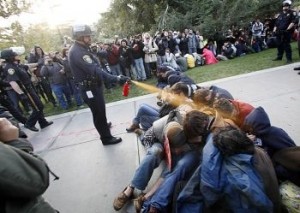
Still from video of Lt. John Pike pepper-spraying peaceful protesters at UC Davis, 11/18/11
I can think of several possible answers:
- The officers chipped in out of their own pockets to buy cases of the hi-test MK-9, which they carefully hid from their commanding officer, Annette Spicuzza, who in turn somehow didn’t notice this switcheroo when the officers under her command carried these humongous canisters into the field in an act of blatant insubordination.
- Chief Spicuzza, at the urging of John Pike and her other macho underlings, agreed to exceed her authority, disregard university regulations, and amp up the firepower of her troops by endorsing the purchase of cases of the military-grade pepper spray, misappropriating department funds in order to do so, deciding also to forego any instruction or training in the use of this higher-octane version.
- The manufacturer of this weaponized version of the spray, Def-Tec/BEA, mistakenly sent the UC Davis Police Force cases of the MK-9 instead of the MK-4, and the member of the force in charge of procurement and checking incoming supplies failed to notice the substitution and correct the shipment, with which the officers then inadvertently equipped themselves.
- The manufacturer sent them a holiday gift of sample cases of the stronger stuff, which they decided to test out — without feeling the need for any instruction and training, university regulations to the contrary.
- Some well-meaning citizen donated cases of MK-9 to them, believing that this police force — whose primary role at the university involves dealing with on-campus bike theft and intoxication — needed more shock and awe options. They decided to test it out without feeling the need for any instruction and training, university regulations to the contrary.
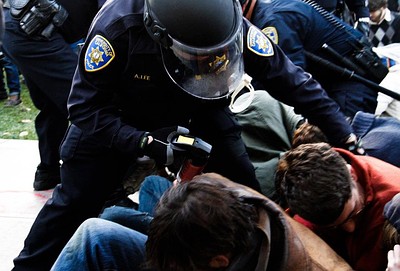
Alexander P. Lee, former officer in the UC Davis Police Dept., in action on November 18, 2011. Photo by N. George Harris, courtesy of Creative Commons.
Myself, I’ll opt for 2, above, as the most-likely-case scenario (pun intended). UCPCD Dispatch Officer Leticia Garcia-Hernandez told the Kroll Report team that she “had never seen the larger MK-9 canister ‘until the day of the video.'” However, later in the report someone identified only as “Officer O” (later revealed as now ex-UC Davis police officer Alexander Lee) states, “I sprayed the crowd directly in front of the police skirmish line using a department issued pepper spray fogger Defense Tech MK-9.” (Italics mine.) This suggests a department-wide conspiracy to violate the restrictions placed on their weaponry by university regulations.
But whichever variant proves true, these remain the key points:
- The students were in the quad legally, as it was the middle of the day, to protest against rising tuition costs.
- They had a legal right to assemble peacefully; the university illegally ordered them to disperse.
- Thus, when they refused to obey the unlawful campus police order to leave, there was actually no legal justification for arresting them, and certainly none for pepper-spraying them.
- And no one on the UC Davis police force had any legal right to possess or use MK-9 pepper spray in the course of his or her duties.
- In addition to all the above violations of federal and state law perpetrated by UC Davis staff and administration, they thus also breached the university’s own “Universitywide Police Policies and Administrative Procedures” as well as its “Principles of Community.”
Film the Police
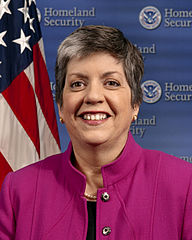
U.S. Secretary of Homeland Security Janet Napolitano, official portrait.
None of the individuals responsible, from former UC president Mark Yudof down to ex-UCD cop John A. Pike III, can get around those hard facts.
Perhaps that’s why the university, with its reputation shredded, had to find someone outside the field of education to replace Yudof. To wit: incoming UC President Janet Napolitano, former Secretary of Homeland Security.
Napolitano comes to UC with no experience whatsoever at running an education institution ― discounting her supervision of the Guantanamo Bay detention center, commonly referred to as Gitmo, which has certainly taught a number of people lessons they’ll never forget. That shortcoming on her resumé won’t prevent her from getting a starting salary of $575,000 plus perks and bennies. She began her tenure as president of UC on September 30, 2013.

Lt. John Pike with pepper spray and Lolspeak caption.
Responsible for deporting a record number of undocumented immigrants during her years at Homeland Security, Napolitano didn’t receive a warm welcome from the UC community. She made things worse by immediately selecting Seth Grossman, former Deputy General Counsel at the Department of Homeland Security (DHS), as her Chief of Staff. Grossman also has no experience running an educational institution.
The combination of a demonstrably incompetent chancellor at UC Davis who has close ties to the FBI and the ex-honcho of Gitmo, expert at suppressing communication by her wards and obstructing observation of their treatment by journalists, makes one wonder exactly what the board of regents of the University of California thinks she brings to the table (beyond a slew of connections to the military-industrial complex), and what they have in mind as the 21st-century shape and purpose of the UC system.
Farewell to A Hero
When people the age of the UC Davis students in 2011 looked for living exemplars of civil disobedience and resistance to oppression, Nelson Mandela surely ranked among the models. As we commemorate his passing, and celebrate his life, we should remember that Ronald Reagan, who stole the presidency from Jimmy Carter by making treasonous deals with the Ayatollah Khomeini, had a very different opinion of Mandela.
The Great Communicator placed Mandela’s African National Congress on America’s official list of “terrorist” groups, vehemently opposing the 1986 Comprehensive Anti-Apartheid Act, which Congress passed over his veto. Reagan called it “immoral” and “utterly repugnant.” And a fuming, frothing Dick Cheney, then the Republican congressman from Wyoming, in 1985 called Mandela a terrorist and voted against a resolution calling for his release from prison.
Yet Reagan and his henchmen cheerfully underwrote Chile’s General Augusto Pinochet, Guatemala’s Efrain Rios Montt, and assorted other vicious right-wing dictators, using the School of the Americas to train their death squads in violating human rights. All of those thugs made the slaughter and “disappearance” of university students and faculty a standard practice.
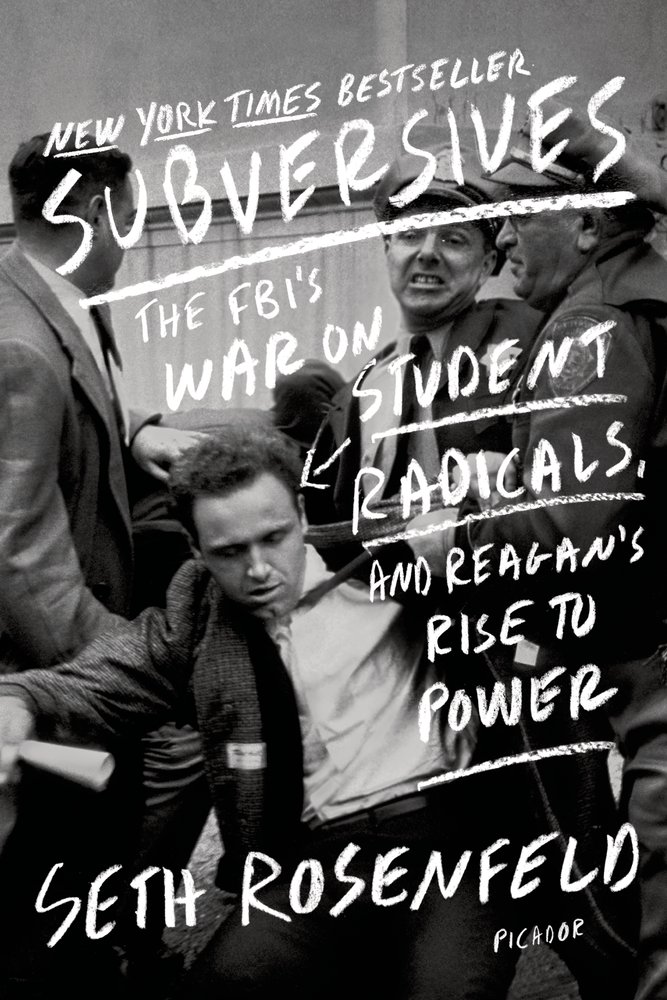
Seth Rosenfeld, “Subversives” (2013), cover.
Compared to student activism in other countries, dissent at post-secondary institutions across North America has remained remarkably peaceful and non-violent. But the use of physical force in the policing of demonstrations on the UC campi traces back to 1966, when Reagan, in his campaign for the governorship of California, began a UC Berkeley-bashing spree that, after his election, turned into the first militarization of a UC campus, eventually involving the imposition of martial law on the entire city of Berkeley. We know now that Reagan had secretly allied himself with then-FBI director J. Edgar Hoover to suppress dissent on college campuses. (See Seth Rosenfeld’s Subversives: The FBI’s War on Student Radicals, and Reagan’s Rise to Power.
There’s a direct line from Reagan’s attack on Berkeley to the current militarization of UC police evidenced in their riot gear and weaponry and aggressive tactics and attitude. There’s another direct line between Reagan’s unholy alliance with Hoover and the connections between Linda Katehi, Janet Napolitano, the FBI, and the Office of Homeland Security. My suggestions to the students and faculty there: Napolitano’s appointment, and her new collaboration with Katehi, do not bode well. Keep a close watch on them. And continue to film the police.
Note: Reader Jean Miele reminds me that the website Photography is Not a Crime provides all the documentation you need to justify photographing and filiming and audio-recording the police in any circumstance.
•
For an index of links to all posts related to this story, click here.
•
This post supported by a donation from the Estate of Lyle Bongé.






Thanks to reader Ellis Vener for pointing me toward the widely circulated photo of a brave Brazilian policeman pepper-spraying an unarmed woman at point-blank range. You’ll see that ex-Lt. John Pike finds himself in good company with uniformed thugs worldwide.